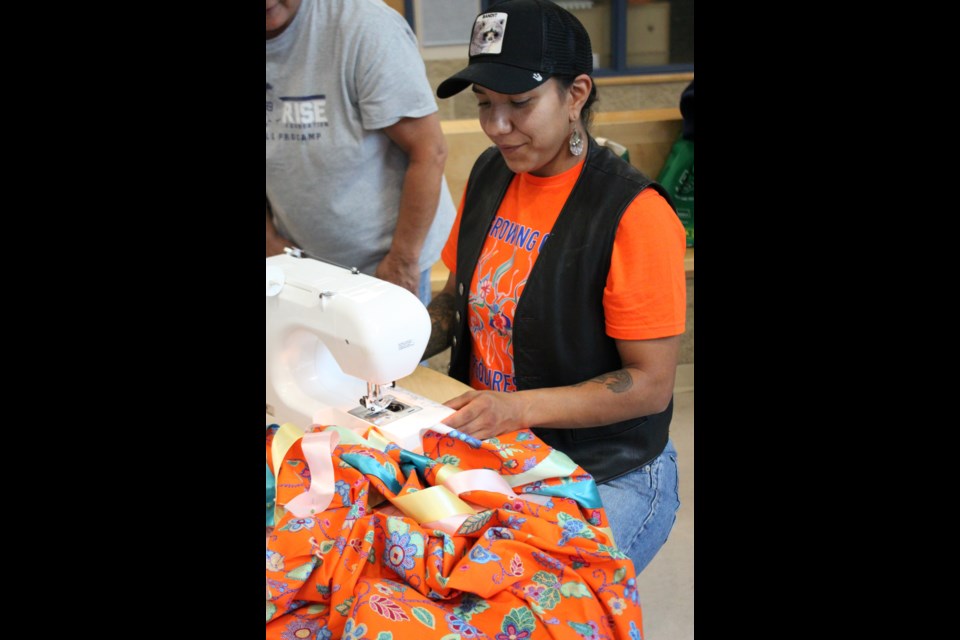BONNYVILLE – In honour of National Day for Truth and Reconciliation, the Lakeland Truth and Reconciliation Society held a ribbon skirt making workshop on Sept. 28 at École des Beaux-Lacs in Bonnyville.
The workshop acted as a way to show solidarity between Indigenous and non-Indigenous people as they came together through a meaningful outlet of self-expression.
“Today is all about reclamation. It’s about bringing things back. When you're talking about a trade item like cloth, these fabrics were almost like an invitation for non-Indigenous and Indigenous people to come together,” said facilitator Beany John.
The workshop held an opening circle to honour seven generations in the past and seven generations in the future.
“That's the first thing we teach is remembering the seven generations... We need to know our history before we can move on to our future. And that's very important,” said John.
John emphasizes that intention setting is everything when a person is creating an item such as a ribbon skirt.
“If you ask every single lady here, they’re going to tell you something completely different about the intentions and meaning of their skirt. To them, it is their story... Each colour will symbolize something different. Or maybe they’ve never hung out with Indigenous people before, and this is their first introduction to what Indigenous people do,” said John. The experience of creating the skirt will be imbued in it, and the skirt will act as a reminder of both the experience they had making it and what symbolism they imparted on the design.
Co-facilitator Kelly Dion-McFeeters shared her experience making ribbon skirts.
“Ribbon skirts are a way for women to express themselves... I like to weave significance into them, and I’m also thinking about practicalities like their intended use,” said Dion-McFetters. “It’s really a women focused activity. All women are beautiful, and they deserve to come and feel empowered.”
Historical context of the Ribbon Skirt
Ribbon skirts have become a way for archeologists to understand not only what First Nations band the skirt was made by, but also who they came into contact with.
“Different Nations had different ways of laying down their beads and threads, so you would be able to tell from the craft,” explained John.
“By identifying and dating the threads and dyes used, you would be able to tell who they came into contact with, because certain people would have certain dyes to trade. So that’s how they could say this is when the French came, because only they had this certain type of dye, and this is where they traded it,” continued John.
John also spoke about pre-colonization - before many knowledge keepers and traditions were wiped out - and how Indigenous people interacted with settlers.
“It was all about taking care of each other. It was about making sure that these newcomers were safe here on this new land, because we saw that they were succumbing to the environment. We had all of the tools to help them. So, one of their trade items that they gave was this cotton cloth,” said John.
Settlers also brought silk ribbons, beads, glass, and different metals. John explains the introduction of the metal needle contributed greatly to the Indigenous culture.
“Needles changed everything. It helped us sew teepees together. A lot of our needles were made out of bone – it took a long time to get those bones and to take care of them.”
Indigenous modes of passing down knowledge typically included oral and pictographic means.
“We had something called winter counts. They were historical accounts of things that had happened. They would have a huge buffalo robe with different historical events, battles, droughts, things like that were drawn on the robe with pictographs. They would be packed up and passed down. An elder would come and unpack them to retell those stories again,” said John. Creating a ribbon skirt holds similarities to this Indigenous tradition, creating a visual story or history.
Diseases brought over from Europe devastated the Indigenous population. Along with cultural assimilation and genocide, many Indigenous knowledge keepers and traditions were lost. But events such as the ribbon skirt making workshop work towards keeping Indigenous culture alive, and kindling positive relationships within communities.



